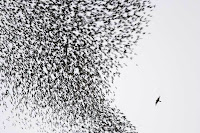
Utilising these variables as factors of consideration within my project in a conceptual manner, I produced a simulation which allows the responder to define an overall geometrical form based upon the physical movement of individual agents, or points. The external parameters of the swarm is defined through the average individually controlled velocity of clusters within the swarm, while the overall direction and focus is determined by the average position of points in the form of a perlin graph.
The internal mechanism of the swarm however is adjusted through individual clusters, centrally based upon the perlin graphs position in space. Where each agent’s velocity and relative position is definable against the central axis of the perlin graph. Furthermore the individual density scale of each agent is adjustable, allowing collectively with the other variables the scale of the swarm to be adjusted while exploring the influence of relative velocities, position and density.
The iterations which have been presented portray a selection of four separate swarms, which explore the altering of the various variables against one another within a three stage time frame. Through such, the responder is able to grasp the influence of such variables against each agent and their reaction within the swarm.


 Set One
Set One








 Extending on the notion of an overall swarm form constructed through individual agents to consider the manner in which whole swarms may interact with one another.
Extending on the notion of an overall swarm form constructed through individual agents to consider the manner in which whole swarms may interact with one another.


















